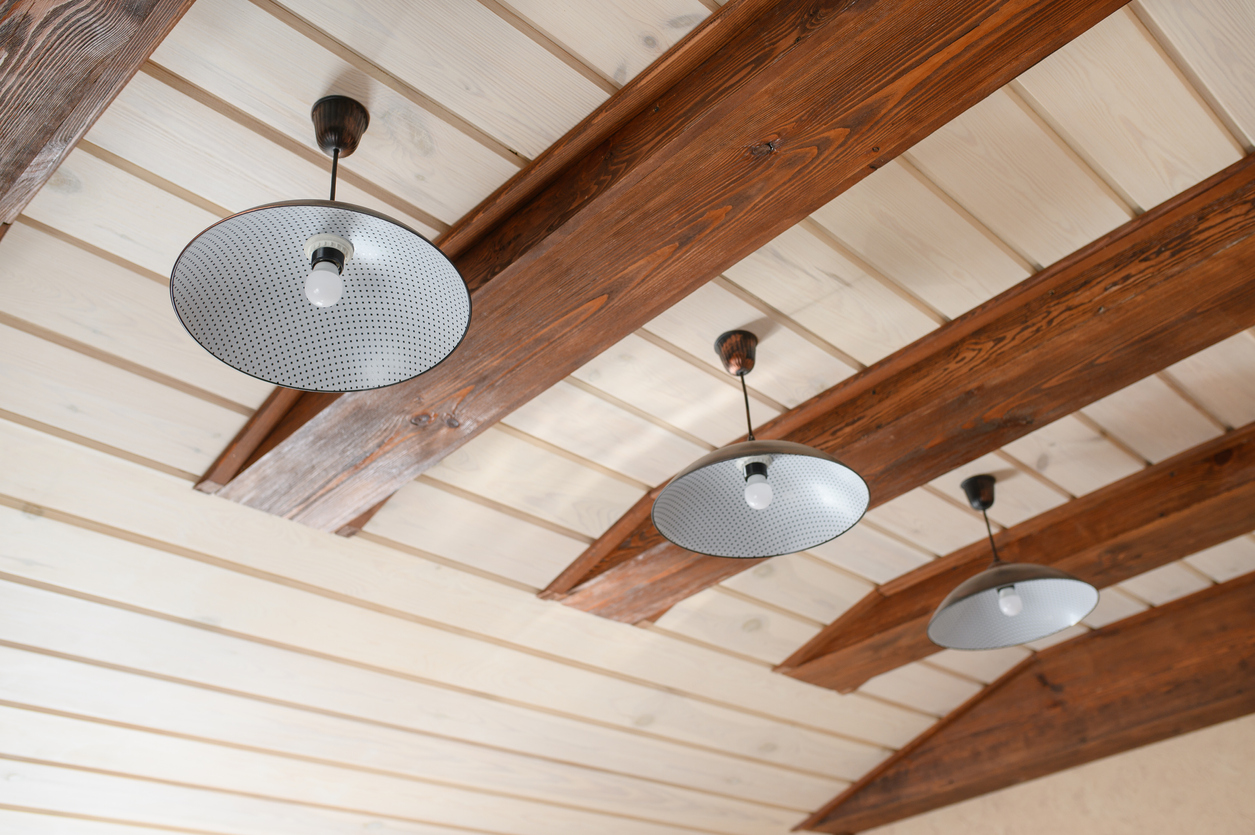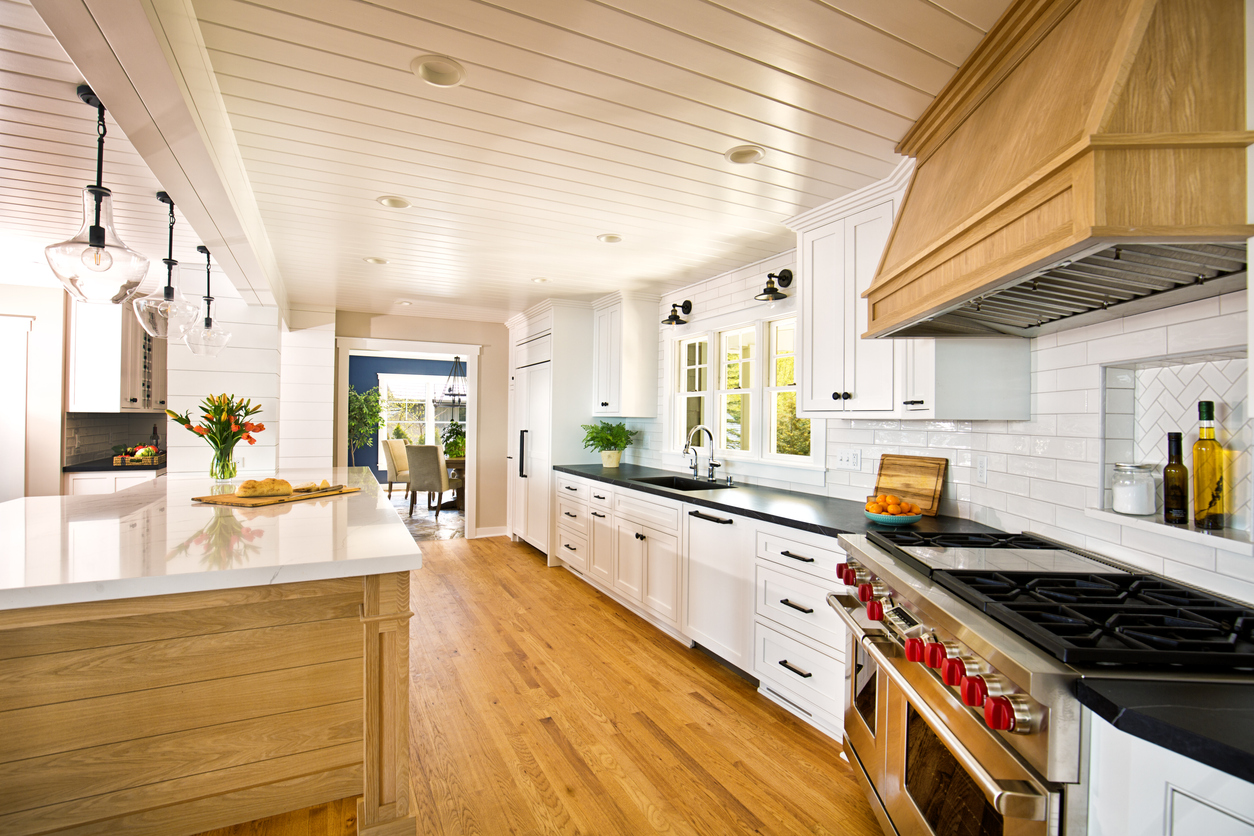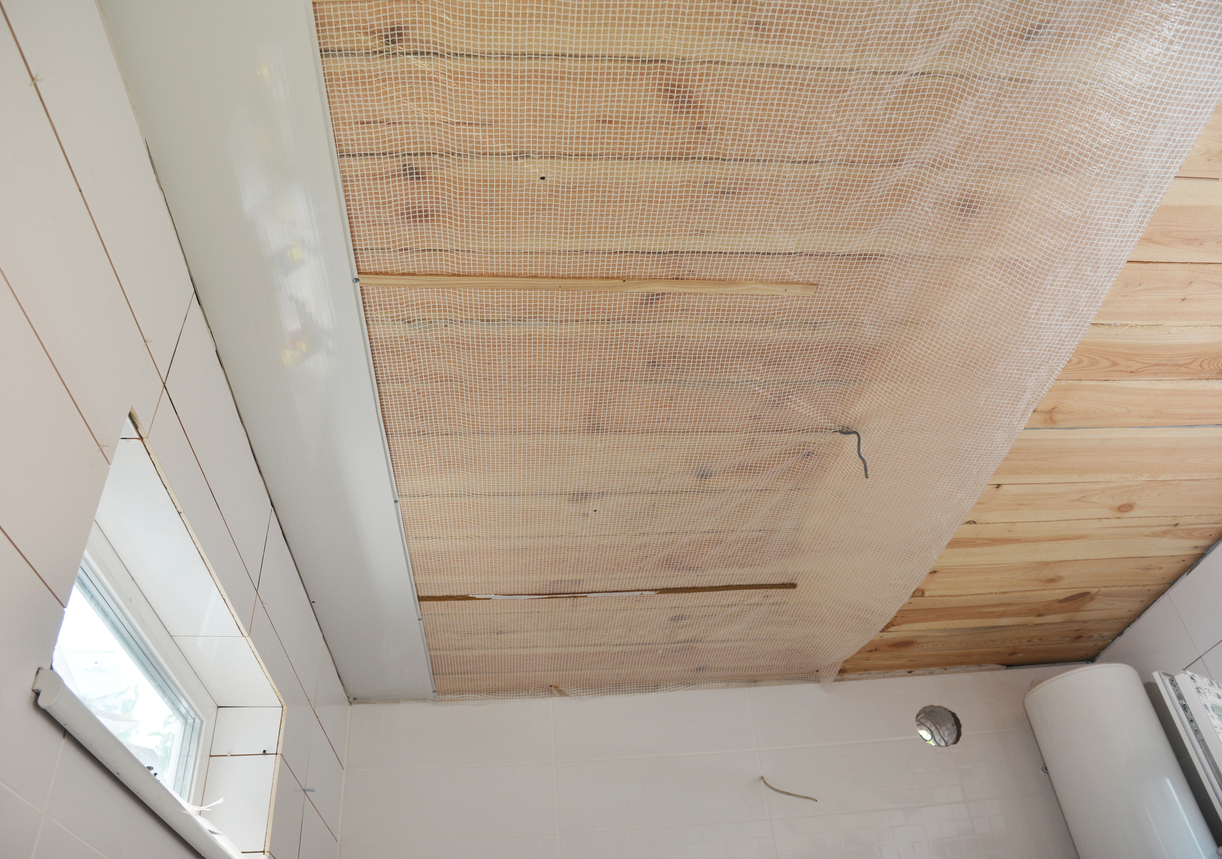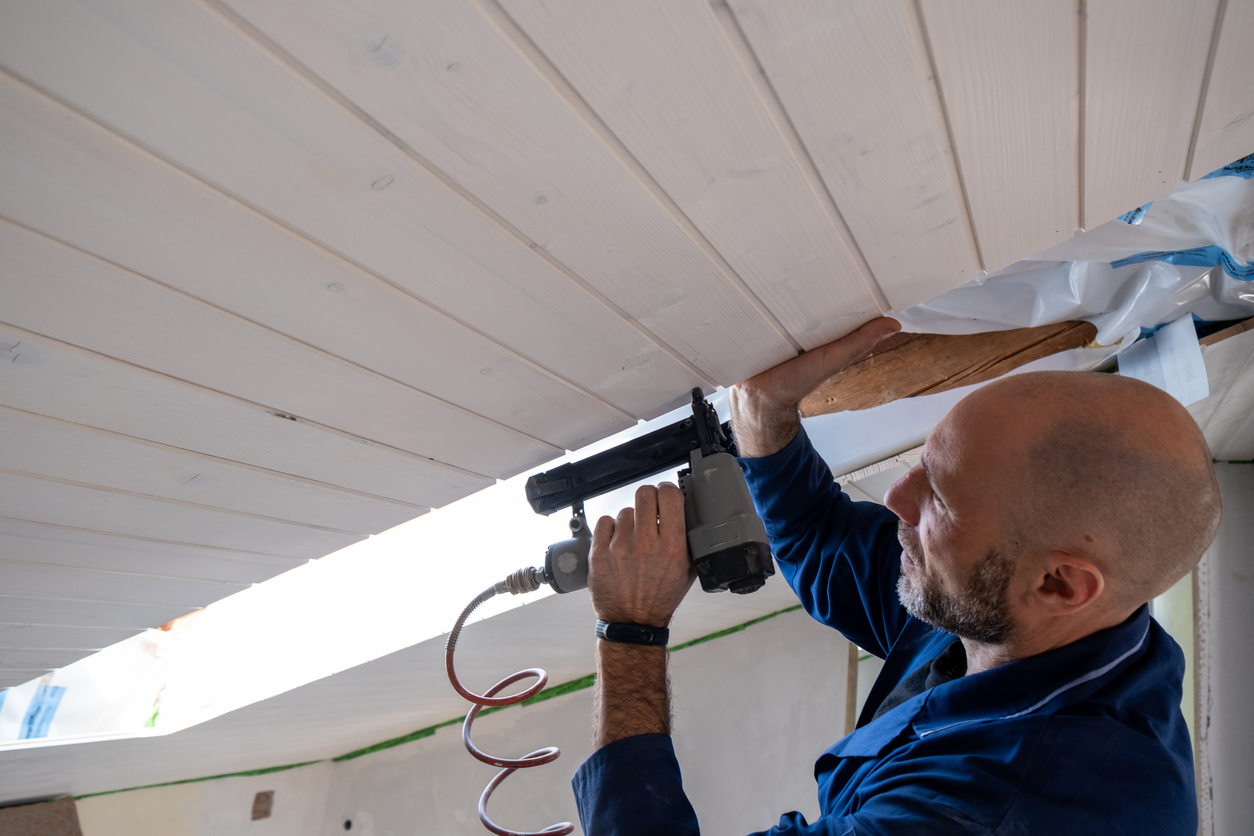

We may earn revenue from the products available on this page and participate in affiliate programs. Learn More ›
Highlights
- The average shiplap ceiling cost per square foot is $2.50 to $7 or about $1,000 for a flat 200-square-foot ceiling.
- Many factors affect the cost of a shiplap ceiling, including the ceiling size and height, board size and type, installation location, labor rates, necessary repairs, and more.
- Homeowners have several benefits when choosing shiplap since it is relatively affordable in addition to being beautiful, durable, and easy to install.
- Working on ladders to install planks of wood in perfect alignment overhead is not an easy job, so many homeowners opt to hire a professional installer to construct a shiplap ceiling.
Shiplap is an aesthetically pleasing and durable ceiling covering that adds depth and design to a room. Originally used for shipbuilding and later as a wall covering to support wallpaper or plaster, shiplap has seen a resurgence in recent years for use on interior walls, ceilings, and exterior siding. It’s incredibly versatile and can be stained or painted to match the aesthetic of the home. Installing it on the ceiling right over existing drywall adds a rustic and inviting touch to a home. “If you have any imperfections from normal wear and tear, either on your walls or ceiling, there is a huge benefit in using shiplap as it will work to cover any imperfections,” explains San Francisco-based project director and interior designer Danielle Nash, who works through Freemodel.
Shiplap ceiling costs between $2.50 and $7 per square foot for the planks of wood, according to HomeAdvisor and Angi. The final price will depend on factors such as the size of the ceiling, the type of wood used, current labor rates, and any repairs that need to be addressed.

Factors in Calculating Shiplap Ceiling Cost
Installing shiplap on the ceiling can add a unique touch and a bit more character to a room. Compared to doing other home improvement projects, attaching shiplap to the ceiling has only a few factors that impact the cost. The main cost factors are the ceiling size, the wood type and board size, and the labor costs to install it.
Ceiling Size
The total square footage of the ceiling is one of the most important factors in determining the cost of a wood shiplap ceiling. The cost of shiplap starts at $0.80 per square foot and can go as high as $7 per square foot, depending on the type of wood used. Therefore, the larger the ceiling, the more the project will cost.
Wood Type and Board Size
The wood type and board size also impact the cost of a shiplap ceiling. Typically, shiplap boards cost between $9 and $15 and are 1 inch thick by 6 inches wide, but other common widths are 5¼ and 7¼ inches. It will take fewer wide boards to cover the ceiling, but these boards will be more expensive. Smaller, narrower boards may be less expensive, but it will take more boards to cover the ceiling. Pricing out the different board sizes can help homeowners make the best choice for their budget and the desired aesthetics of the space.
Another factor that impacts the cost to install a shiplap ceiling is the type of wood the boards are made of. Hardwood shiplap boards are typically the least expensive ($0.80 to $4 per square foot), while cedar is the most expensive ($2.50 to $7 per square foot). Pine boards fall in the middle of the price range ($2.50 to $4 per square foot).
Hardwood works well for homeowners who are looking for long-lasting durability and the unique color and appearance of a wood like walnut or cherry. Cedar resists pests and wood rot naturally, so it has a long lifespan, and pine is a durable and cost-effective choice that can be stained or painted many different colors.
Sometimes homeowners are confused about whether shiplap is a tongue-and-groove type of wood. The major difference between shiplap and tongue-and-groove boards is that shiplap has L-shape rabbeted joints that overlap to create a tight seal and a groove down the middle for that intentional gap. Tongue-and-groove is made of boards that fit into each other snuggly without a gap.
Labor
Having a professional carpenter install shiplap will cost between $35 and $100 per hour for labor. Exact rates will vary by geographic location. Installing shiplap on the ceiling will likely cost on the higher end of the range due to the additional effort, time, and risk it takes to install the boards overhead. A shiplap attic ceiling also costs more since the carpenter may be working in tight quarters, leading to a longer installation time. A shiplap vaulted ceiling comes at a higher cost as well due to the height and difficulty of lifting and installing the boards while standing on scaffolding or ladders. Pro installers know how to install shiplap on ceilings, walls, and exterior siding.

Additional Costs and Considerations
The shiplap boards and labor will likely be the bulk of the cost to bring shiplap ceiling ideas to life, but there are additional costs and considerations that can impact the final cost of the project. Damaged ceilings that need repair or replacement will affect the cost, as will the choice of prefabricated or plain boards.
Ceiling Repairs
While shiplap can conceal some types of ceiling damage, such as minimally cracked drywall, other issues may need to be repaired first. If the installation area has been damaged by a water leak, if the drywall is sagging, or if there is structural damage, the ceiling needs to be repaired prior to shiplap installation. Ceiling repairs cost between $419 and $1,359, which will increase the total project’s price, but it’s worth the cost in the long run to ensure that the ceiling is structurally sound and can hold the shiplap securely.
Prefinished vs. Plain Boards
Choosing plain boards can save homeowners some money compared to choosing prefinished boards. Prefinished boards are available already painted or stained, which makes for a fast installation without additional finish work. Plain boards will need to be finished before installation and will require stain or paint to finish the wood.
When homeowners are deciding between the two types of boards, it’s important for them to factor in time as well. If they are on a tighter budget but have the time to finish the boards themselves, then plain boards may be a better option. If their budget has a little more wiggle room, then prefinished boards can save time and help the project go faster.
Additional Materials
Shiplap installation requires more than just the boards, so homeowners can expect to factor in the cost of additional materials. Most of the materials are general construction materials that are needed in woodworking projects. Contractors often have many of these materials on hand and build the price into the cost, whereas homeowners who are DIYing the project may have to pay full retail price at the local hardware store. For installing shiplap on a 12-foot by 14-foot ceiling, costs can be broken down by the materials needed as follows:
| Material Type | Average Cost (Materials Only) |
| Finish | $22 to $26 |
| Nails | $2 to $6 (two 5-pound boxes) |
| Paint | $20 to $100 per gallon |
| Primer | $100 to $125 (4 to 5 gallons) |
| Spackle | $10 to $20 (1 to 2 buckets) |
| Underlayment | $75 to $90 |
| Wood filler | $15 to $20 |
Shiplap Ceiling Cost by Type of Wood
The type of wood the shiplap is made from is an important cost factor for homeowners to consider. Hardwood is the least expensive shiplap material, but if homeowners want to save a little money, they can buy medium-density fiberboard (MDF) or plywood panels. The drawback is that manufactured wood does not come with the rabbet edges of traditional shiplap boards, so it’s trickier to achieve the iconic gaps between the boards.
Another option homeowners can consider is PVC shiplap. While a PVC shiplap ceiling isn’t as authentic as wood, it can offer a similar look with no long-term maintenance or finish work required. PVC shiplap costs around $2.50 per square foot, making it a good option for a cheap DIY shiplap ceiling.
| Type of Wood | Average Cost (Materials Only) |
| Cedar | $2.50 to $7 per square foot |
| Hardwood | $0.80 to $4 per square foot |
| Medium-density fiberboard (MDF) | $15 to $60 per sheet |
| Pine | $2.50 to $4 per square foot |
| Plywood | $40 to $70 per sheet |
Cedar
Naturally rot- and pest-resistant, cedar is a popular choice of wood, though it’s one of the most expensive options for a shiplap ceiling. It is also a good option for an outdoor shiplap ceiling under a gazebo since it won’t warp or decay quickly when exposed to the elements. Cedar costs between $2.50 and $7 per square foot.
Hardwood
Made from different species of hardwood, such as oak, maple, and cherry, hardwood shiplap is the most common type of shiplap and costs between $0.80 and $4 per square foot. It’s suitable for indoor or outdoor use as well. “If durability is a concern I would lean towards oak,” says Nash. “It provides a classic look; however, it is on the pricier side.”
Medium-Density Fiberboard (MDF)
A manufactured wood, medium-density fiberboard (MDF) comes in sheets that are typically 4 feet by 8 feet. This means that if it’s used for shiplap, the boards will need to be cut into planks and finished with stain or paint. Since the boards will be cut straight with a table saw or circular saw, they won’t have the rabbet edges (L-shaped groove) like traditional shiplap. To achieve the gap, installers will need to ensure they level and space each board precisely. These boards are cheaper up front, but installation is more labor intensive. A sheet of MDF costs between $15 and $60, and it can be cut into seven or eight planks.
Pine
Pine is a common material that can help homeowners realize their shiplap ceiling design ideas in any room of the house. This material falls in the middle of the price range, between $2.50 and $4 a square foot. Its natural colors and textures allow it to add depth to a ceiling design whether it’s sealed, stained, or painted. Pine is the traditional choice for a beadboard ceiling, if that’s the look a homeowner is going for.
Plywood
Like MDF, plywood comes in 4-foot by 8-foot sheets and can be cut into seven or eight planks. This manufactured wood will have the same challenge that it doesn’t have the rabbets to connect each plank. Precision leveling during installation will be key to achieving a uniform look with gaps between each board. Plywood is more expensive than MDF, with one sheet costing between $40 and $70.

Benefits of Choosing Shiplap for a Ceiling
Shiplap’s rise in popularity as an interior ceiling covering comes after a long history as a shipbuilding material then as a wall covering intended to be used as the backing for wallpaper, drywall, or plaster. There are many benefits to choosing this historic building material as a cheaper alternative to drywall.
Easy Installation
If homeowners choose prefinished boards, then installing shiplap is as simple as measuring, cutting, and nailing the shiplap boards to the ceiling. Though the installation itself is easy, installing shiplap on the ceiling comes with the inherent difficulty of working overhead, so it’s likely that two installers will work together to ensure a quality finish. There’s no need for the labor-intensive work that comes with drywalling, mudding, and finishing walls when shiplap is used.
Durability
Each type of wood has its own durability, but overall, wood is a long-lasting indoor building material. There are added benefits depending on the type of wood. For instance, cedar’s natural oils provide protection against rot and pest infestation, making it an especially good choice for outdoor shiplap installations. Hardwood is also durable enough to be used outside and is often used as exterior siding. And pine comes with a natural beauty that is perfect for any ceiling and needs only a little sealant to keep it vibrant.
Affordability
Installing shiplap on a ceiling is an investment that will pay off in the long run. Given its lifespan, shiplap offers superior affordability. The cost of shiplap installation isn’t always cheaper than the cost of drywall installation since having a drywaller finish a ceiling with a very smooth surface can be expensive. So, it may be worth having shiplap installed for a unique look that requires little to no maintenance yet draws a lot of attention. If a homeowner is working on a home renovation and discovers that shiplap was used in the ceiling under the existing drywall, it’s much cheaper to simply refinish it for a fresh look.
Aesthetics
Many shiplap kitchen ceiling ideas bring an added warmth to a kitchen. With a variety of finish options, shiplap can offer a beautiful look that fits with a range of decor styles and aesthetics in any room of the house. Though popular in the modern farmhouse style, shiplap ceilings also pair well with minimalist designs, cottage-chic styles, and Victorian-style homes.
“For ceilings, shiplap can create the illusion of height and add architectural interest,” explains Nash. “[Additionally], horizontal lines of shiplap on a ceiling can visually widen a space.”

Shiplap Ceiling Installation: DIY vs. Hiring a Professional
While experienced DIYers may be comfortable installing shiplap on a wall or two, it’s a different story to install it on a ceiling. There are additional risks, concerns, and physical demands to working on tall ladders on surfaces overhead. Attaching shiplap to the ceiling is best done with a helper who can stabilize the boards and keep them level.
Working overhead can be difficult and means not only contending with the standard difficulties of a DIY project but also having easy access to tools and additional arm strength to hold the boards in place. These are the primary reasons homeowners often leave a shiplap ceiling job to a pro.
Installers have the right tools, equipment, and expertise to safely work on ladders and ensure the final product looks great. It’s an even better option to hire a pro when the homeowner has a particular design they want built into the ceiling. The carpenter will put together a design plan and estimate the right number of materials to execute on the homeowner’s vision. This often saves homeowners time and wasted resources trying to do it on their own.
How to Save Money on Shiplap Ceiling Cost
Installing a shiplap ceiling is an exciting way to bring more character and charm into the home. Though it’s cheaper than drywall, homeowners may still be interested in looking for ways to save money on shiplap ceiling costs.
- DIY the finish. Homeowners can choose plain boards and prime and paint them on their own rather than paying for the extra labor to finish them.
- Opt for low-grade wood. Sometimes homeowners can choose a lower-quality board that comes with some knots or holes if they prefer an even more rustic look than average.
- Compare quotes. Homeowners are encouraged to ask for quotes from multiple contractors and compare them for the best value.
- Shop around. Comparing prices of shiplap boards at multiple hardware stores and lumberyards may help homeowners save on the total material cost, although it’s worth asking if the installer can get them at a cheaper price too.
- Choose a cheaper wood. Boards made from pine or hardwoods are cheaper than cedar or MDF boards.
Questions to Ask About Shiplap Ceiling Installation
Asking questions about the process of installing a shiplap ceiling can help homeowners be more comfortable with the project and prepare them for any prep work or expectations before and during installation.
Are you licensed and insured?
- How many shiplap ceilings have you done?
- Can I see a portfolio of your work and speak to references?
- How long will this job take?
- Do I need to be home while you’re installing the shiplap?
- What can I do to prepare the space for the project?
- What does the cleanup process look like?
- Which material will be cheaper overall for this size of a ceiling: prefinished or plain boards?
- Do you warranty your work?
- Do you provide a written quote?
- Who will my point of contact be throughout the project?
- Will you need to hire any subcontractors (e.g., electricians, plumbers, etc.)?
FAQs
A beautiful shiplap ceiling can add an unexpected element to a room that draws attention to it. This timeless material has been used for many years to protect the walls or to add a design element in its own right. In recent years, shiplap walls and ceilings have seen a resurgence in popularity. Though homeowners may have seen it used in countless home design shows, they may still have some questions about using it in their own home.
Q. Is shiplap on a ceiling a good idea?
Shiplap on a ceiling can be a great idea for enhancing a room’s design and adding character to an often overlooked area. While installing shiplap on a ceiling is a little more difficult than installing it on the walls, it’s a project that can be completed relatively quickly and that will bring charm to the room. It can also be cheaper than installing drywall and adding a smooth surface.
Q. What is the cheapest type of ceiling?
The cheapest type of ceiling is typically a drywall ceiling. Drywall is sold in 4-foot by 8-foot sheets that typically cost about $12 to $20 each. This averages out to a cheaper materials cost than shiplap since one sheet of drywall covers much more surface area than a plank of wood. Drywall installation is more labor intensive, but it can still be a little cheaper than shiplap in many cases.
Q. Is it expensive to vault a ceiling?
Vaulting a ceiling costs between $4,800 and $38,000 depending on the size of the ceiling, its location, labor costs, and worksite preparation. While this is an expensive home improvement project that can require structural changes as well as HVAC and electrical modifications, it also offers many benefits, such as more natural light, enhanced aesthetics, and higher home value.
Q. How is a shiplap ceiling installed?
A shiplap ceiling is installed by attaching shiplap boards or manufactured wood planks to the ceiling. The boards can be laid out in vertical, horizontal, or custom designs. To install the ceiling, professionals work on ladders or scaffolding, lift the measured and cut boards overhead, then attach the boards to the ceiling with nails.
Q. Can you put shiplap over a plaster ceiling?
It’s possible to put shiplap over a plaster ceiling, but installers will need to make sure the plaster is in good condition or make repairs before beginning the shiplap installation. As with many other home projects involving wall coverings, shiplap should be attached to studs to ensure long-term stability. Installing shiplap is a good way to add depth to a boring plaster ceiling and cover minor damage.
Q. Can you shiplap a ceiling without drywall?
Shiplap can be installed on a ceiling without drywall; it will be nailed directly to the ceiling joists. In this case, true shiplap boards with rabbeted joints are the best option to prevent any actual gaps between the boards and to ensure a proper seal across the ceiling. Alternatively, a pro can install drywall and attach shiplap without taping or mudding the drywall. This method can cut down on time and cost and allow for the use of manufactured boards too.
Sources: Angi, HomeAdvisor, Elite Trimworks, UFP Edge
